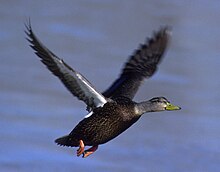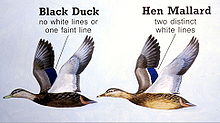American Black Duck
| American Black Duck | |
|---|---|
 | |
| American Black Duck in flight | |
| Conservation status | |
| Scientific classification | |
| Kingdom: | Animalia |
| Phylum: | Chordata |
| Class: | Aves |
| Order: | Anseriformes |
| Family: | Anatidae |
| Subfamily: | Anatinae |
| Genus: | Anas |
| Species: | A. rubripes |
| Binomial name | |
| Anas rubripes (Brewster, 1902) | |
| Synonyms | |
Anas obscura
| |
The American Black Duck (Anas rubripes) is a large dabbling duck. American Black Ducks are similar to Mallards in size, and resemble the female Mallard in coloration, although the Black Duck's plumage is darker. It is native to eastern North America and has shown reduction in numbers and increasing hybridization with the more common Mallard as that species has spread with man-made habitat changes.
Description
American Black Ducks weigh 720–1,640 g (1.6–3.6 lb), measure 48–63 cm (19–25 in) in length and 88–96 cm (35–38 in) across the wings.They are similar to Mallards in size, and resemble the female Mallard in coloration, although the Black Duck's plumage is darker. The male and female Black Duck are generally similar in appearance, but the male's bill is yellow while the female's is a dull green. The head is slightly lighter brown than the dark brown body, and the speculum are iridescent violet-blue with predominantly black margins. The Black Duck has orange legs and dark eyes. In flight, the white underwings can be seen in contrast to the dark brown body. The behaviour and voice are the same as for the Mallard drake.
Breeding
Their breeding habitat is alkaline marshes, acid bogs, lakes, ponds, rivers, marshes, brackish marshes, and the margins of estuaries and other aquatic environments in northern Saskatchewan, Manitoba, across Ontario and Quebec as well as the Atlantic Canadian Provinces, including the Great Lakes, and the Adirondacks in the United States. Female Black Ducks lay an average of 9 eggs.
Black Ducks interbreed regularly and extensively with Mallard ducks, to which they are closely related. Some authorities even consider the Black Duck to be a subspecies of the Mallard, not a separate species at all; this is in error as the extent of hybridization alone is not a valid means to delimitate Anas species.
It has been proposed that in the past, Black Ducks and Mallards were formerly separated by habitat preference, with the dark-plumage Black Ducks having a selective advantage in shaded forest pools in eastern North America, and the lighter plumage Mallards in the brighter, more open prairie and plains lakes. In recent times, according to this view, deforestation in the east, and tree planting on the plains, has broken down this habitat separation, leading to the high levels of hybridization now observed. However, rates of past hybridization are unknown in this and most other avian hybrid zones, and it is merely presumed in the case of the American Black Duck that past rates were lower than those seen today. It should also be pointed out that many avian hybrid zones are known to be stable and longstanding despite the occurrence of extensive interbreeding. At any rate, American Black Ducks and local Mallards are now very hard to distinguish by means of microsatellite comparisons, even if many specimens are sampled Contrary to this study's claims, the question whether the American haplotypes are an original Mallard lineage is far from resolved. Their statement, "[N]orthern black ducks are now no more distinct from mallards than their southern conspecifics" of course only holds true in regard to the molecular markers tested. As birds indistinguishable according to the set of microsatellite markers still can look different, there are other genetic differences that were simply not tested in the study.
The hybrids cannot be readily distinguished in the field and consequently, much of the species' hybridization dynamics remains unknown. It has been revealed in captivity studies, however, that the hybrids follow Haldane's Rule, with hybrid females often dying before they reach sexual maturity this underscores the case for the American Black Duck being a distinct species.
This species is partially migratory and many winter in the east-central United States, especially coastal areas; some remain year-round in the Great Lakes region. These birds feed by dabbling in shallow water, and grazing on land. They mainly eat plants, but also some molluscs and aquatic insects. The eggs are a greenish buff color. They lay from 6–14 eggs, and hatch in an average of 30 days.
This duck is a rare vagrant to Great Britain, where, over the years, several birds have settled in and bred with the local Mallards. The resulting hybrids can present considerable identification difficulties.
Status
The Black Duck has long been valued as a game bird, being extremely wary and fast on the wing. Although this is a species of least concern, it is slowly declining due to habitat destruction. Some conservationists consider the hybridization and competition with the Mallard an additional source of concern, should this decline continue. The hybridization itself is not the major problem; natural selection will see to that the best-adapted individuals still have the most offspring. But the reduced viability of female hybrids will cause many broods to fail in the long run as the offspring die before reproducing themselves. While this is not a problem in the plentiful mallard, it will place an additional strain on the American Black Duck's population.





No comments:
Post a Comment